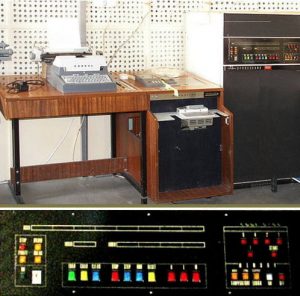Practicomp 4000 minicomputer
Well ahead of personal computers, Vilati began developing this small machine in the early 1970s. Not having a predecessor, they built it based on their own experiences; most of the problems were caused by the design of the main memory. This was mainly the reason why it did not achieve the hoped-for success, and the gradually emerging personal computers pushed it out of the market.
(The picture shows the cabinet containing the central unit next to the console table, with the control panel highlighted below.)
Own development
Károly Balotai, hardware and software designer
Mihály Kaiser, hardware designer
Use
Corporate governance and accounting tasks
Construction process control
Printing text processing and typographic tasks
Secondary education
- Alföldi Printing House (Debrecen)
- Debrecen Water and Sewerage Works
- Danube Ironworks (Dunaújváros)
- Road Construction Company (Debrecen)
- Hungarian People's Army (Cegléd)
- Nyíregyháza Rubber Factory
- Perczel Mór High School (Csurgó)
- Szabolcs County Construction and Installation Company
Structure
Central unit
Word-organized machine: 32 bpW
- control system: self-developed control circuits
- main tank: up to 8 KW; available in three versions:
- self-developed magnetic disk storage
- ferrite ring RAM
- self-developed (semiconductor) DRAM
- calculator:
- fixed-point arithmetic, with single and double length factors
- 3-word math accelerator ("coprocessor")
- bus interfaces instead of channels for two external devices
Periphery
- backup: initially none; during later developments:
- 2*180 kB floppy disks ( MOM )
- 1MB hard drive
- external devices:
- control panel
- Prepaline console table
- Consul electric typewriter
- 8-track punched tape reader
- 8-lane punch tape punch (PerfoMOM 35)
- optionally:
- VT100 standard CRT monitor
- DZM180 dot matrix printer
Operation
The supervisor program had to be read from punched tape and started manually at startup.
Before there was a backup memory, if the main memory was full, the calculation results were temporarily punched onto punched tape and then read back from there when needed; this slowed down the operation of the machine considerably.
Although the implementation of operations was significantly accelerated by the installation of back-up storage, the speed of the central control system did not increase significantly.
The control panel helped to check the operation and correct errors: the LED displays showed the contents of the selected registers, and the switches not only allowed to modify their contents, but also to intervene in the execution of operations.
Program set
- the operating system was replaced by a self-developed monitoring program
- compilers:
- Autocode
- reduced Fortran
Policomp publication editor
Historical curiosities
The Prepaline table – disconnected with a switch – also functioned as a standalone data preparation device.
The magnetic disk main memory was unreliable, so it was only used in a few copies; the ferrite memory, on the other hand, proved to be too expensive for a small computer intended for a low-cost market. That's why they switched to semiconductor DRAM memory - the idea predated RAM chips by almost a decade! True, 32 KB took up a lot of space at the technical level of the time.
Practicomp's greatest merit is that, thanks to its reasonable price, it made it possible for small businesses to introduce computerized management and record-keeping methods.
Resources
Detailed technical description: Practicomp 4000
IT developments in Vilati
A printing application: The Policomp system
Created: 2017.11.05. 19:32
Last modified: 2025.02.24. 18:18

